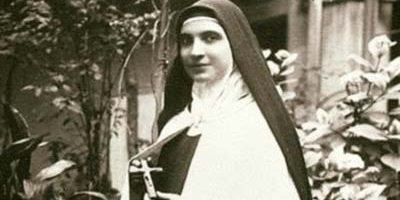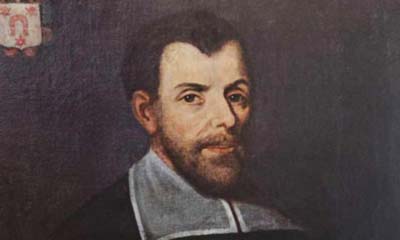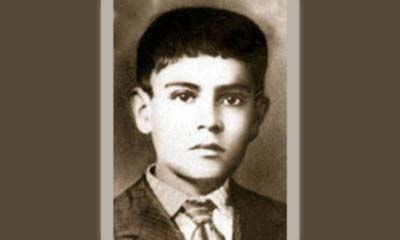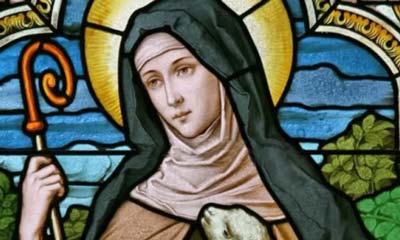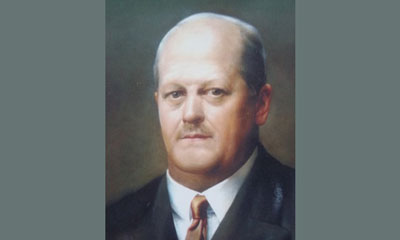April 1, 2020
Blessed Elia of Saint Clement
Dear Friends,
“The consecrated life,” wrote Pope John Paul II, is “one of the tangible seals which the Trinity impresses upon history, so that people can sense with longing the attraction of divine beauty… The contemplative life [is] a constant reminder that the primacy of God gives full meaning and joy to human lives, because men and women are made for God, and their hearts are restless until they rest in him… [T]he life of cloistered nuns, devoted in a special way to prayer, asceticism, and diligent progress in the spiritual life, is nothing other than a journey to the heavenly Jerusalem and an anticipation of the eschatological Church immutable in its possession and contemplation of God” (Apostolic Exhortation Vita Consecrata, March 25, 1996, Nos. 20, 27, 59). Blessed Elia of Saint Clement, who was beatified in 2006, is one of the bright lights of Carmelite contemplative life. “Her passing streaked across the sky of Bari like a sparkling meteor,” said Archbishop Magrassi, of Bari (southern Italy), “and left a trace of light that has not gone out. She was like ‘a smile from God’ for our time, her city, and the entire Church.”
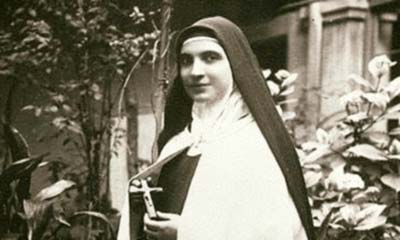 Theodora (Dora) Fracasso was born in Bari on January 17, 1901, the third of nine children. She herself declared that her parents were “true saints.” Her father ran a small painting company. Along with his wife, he was one of the main sacristans of the “Santa Maria del Pozzo” confraternity at the neighboring church, Saint Mark’s. Every day, they recited the rosary as a family. The mother spoke to her children about the soul, God, the Blessed Virgin Mary, Heaven, and eternal life. At the age of two, following the custom of the time, Dora received Confirmation from the Archbishop of Bari. Every night before going to sleep, she would place a small flower at the feet of Our Lady, symbol of the sacrifice she had made that day in her honor. One day she asked her mother: “Mommy, do good girls see their soul? Have you seen yours?” “My little one, the veil of this body hides it. It is inside us and only after we die will we be able to see it.”
Theodora (Dora) Fracasso was born in Bari on January 17, 1901, the third of nine children. She herself declared that her parents were “true saints.” Her father ran a small painting company. Along with his wife, he was one of the main sacristans of the “Santa Maria del Pozzo” confraternity at the neighboring church, Saint Mark’s. Every day, they recited the rosary as a family. The mother spoke to her children about the soul, God, the Blessed Virgin Mary, Heaven, and eternal life. At the age of two, following the custom of the time, Dora received Confirmation from the Archbishop of Bari. Every night before going to sleep, she would place a small flower at the feet of Our Lady, symbol of the sacrifice she had made that day in her honor. One day she asked her mother: “Mommy, do good girls see their soul? Have you seen yours?” “My little one, the veil of this body hides it. It is inside us and only after we die will we be able to see it.”
A small lily
When she was around four years old, Dora had a dream that had a strong impact on her: “I dreamed there was a patch of fragrant lilies in front of our house, near the door. A very beautiful young lady in a white coat, with eyes that sparkled like stars, walked through the flowers with a golden sickle in her beautiful hands. With a heavenly smile on her lips, she delicately touched the white lilies on her left and on her right; so touched, they gently bent towards her. When she reached the end of this completely white field, the beautiful woman bent forward and, having laid down the sickle, picked a small lily. She looked at it, admired it a moment, and then pressing it to her heart, disappeared.”
The next morning, the little girl excitedly recounted her dream to her mother. “After listening to me with emotion, Mommy lifted me in her arms and covered me with kisses, saying: ‘My daughter, that was the Virgin Mary, who pressed your little soul against her heart in an act of kindness. You honor her every day, and she wanted to reward you by coming to you while you slept.’”
“The following morning,” Dora continued, “No more games or playing for me! I felt pensive, and avoided my little sister so I could think about the beautiful lady. To recollect myself I went to a corner of the garden; by chance my glance fell on a bush of red roses, in the midst of which was one in full bloom—beautiful, very beautiful. I thought I saw in it an image of the Queen of Heaven. I knelt before it, my hands joined, and prayed, deeply moved, with tears in my eyes: ‘My Good Lady, how beautiful you are! Mommy told me you are the Queen of Angels, the Lady of Heaven, oh, how I want to love you! I offer myself to you so that I will never, never be part of this world, and when I grow up I will be a nun!’” From that day on, she wrote, “My little heart felt an ardent thirst for God: the desire for God and the thought of being a nun never left me.” A little later, Dora had an extraordinary spiritual experience that lasted twelve days: “I felt that I had been created for Heaven, and that the things of this world had absolutely no importance to me.” She started noticing small details, such as a blade of grass no one else gave any thought to, but which drove her to adoration, on her knees, deeply moved; her eyes raised to the sky, she felt an invitation to join the Paradise of the elect.
The art of embroidery
Dora was lively, simple, spontaneous, and easily moved. She was a good friend and attentive to others. She was described as “a healthy, intelligent girl who liked and wanted beautiful things. She appreciated being liked and wanted to please everyone.” She happily played with her younger sister, Domenichina, but preferred the open air of the garden, walks with her father along the sea under Bari’s intense sun, and the starry sky of summer nights. In 1906, she became a student at the Institute of the Stigmata Sisters (the “Poor Daughters of the Holy Stigmata of Saint Francis,” a women’s religious congregation dedicated to educating girls). She enjoyed sewing and spent a lot of time in the embroidery room, progressing to the point of working with the Institute’s Sisters. She joined parish groups for children and teenagers in the neighboring church run by the Dominican Fathers.
At the age of ten (1911), Dora received her first Communion, after being carefully prepared by her first Confession. During the ten days of her preparatory retreat, she spent many hours alone in front of the tabernacle: “Jesus,” she wrote, “I feel lost in you like a speck of dust thrown into a furnace!” The night before the ceremony, she had a mysterious dream during which St. Thérèse of the Child Jesus (Thérèse of Lisieux), of whom she had never heard, said to her: “You will be a nun like me, ‘Sister Elia,’“ and revealed to her that her life would be very short, like her own. From then on, Dora called Thérèse, “My very dear Friend from Heaven.” That day, Jesus revealed to her that she would become a little victim of his merciful love, and that she would suffer greatly on earth. From then on, Dora received Communion daily.
On April 20, 1914, while she waited to enter a convent, Dora was admitted to the Dominican Third Order under the name of Agnes. Two years later, she was still working for the Stigmata family and from her salary contributed to her family, for during the Great War her father found it hard to provide for it. Some nights, Dora worked by candlelight to save electricity. Drawn by her spiritual life, friends gathered around her, forming one heart and one soul. Domenichina shared her sister’s love of the Lord; their relationship resembled the one that united St. Thérèse of Lisieux with her sister Céline. Domenichina followed Dora into Carmel and received the name Sister Céline.
Dora was attentive to her father’s employees and their families, taking special care of newborns. She made sure that the workers went to Mass on Sunday and offered their work to God, that women received Communion before delivering a child and baptized their children within eight days of birth. When a worker died, she went to the cemetery to pray at their grave. Her father continued to cater for a worker whose arms were paralyzed, and at lunchtime Dora would bring him a bowl of soup and tenderly feed him. She knew how to resolve disputes and was concerned about the salvation of souls, wanting to lead all to God.
More than a sermon
Like young Thérèse, Dora thought of the missions in “barbarian lands in the far off Americas.” Yet she understood that great external works were not necessary, but rather, love and complete self-sacrifice. During the Great War, anti-clericalism was expressed through measures that persecuted the Church. The Dominican convent was shut down, under the pretext of spying for Austria. Bari was a large port on the Adriatic Sea directly across from Dalmatia, at the time part of Austria. The Stigmatines were banned, and everywhere blasphemers freely offended God. One night, one of them dared to blaspheme in the Fracasso home. Indignant, Dora cried out: “Sir, in our home we do not blaspheme! If you want to do so, leave!” “Thank you, miss!” replied the unfortunate man. He confessed to a friend, “That rebuke was worth more than a sermon!”
Another evening, a young husband came to pick up his wife who worked for the Fracassos. “Mama,” Dora insisted, “that man is not in God’s grace.” Shortly after, he fell sick. A priest was called to administer the sacraments, but had to leave because of the man’s bad attitude. Behind the bedroom door, Dora cried and prayed. At one point, she realized the sick man was looking for something. She approached him, took out a crucifix, and offered it to him. He kissed the crucified Jesus, unknowingly imitating the gesture of Pranzini, the condemned man for whom St. Thérèse had prayed. Another time, an elderly woman, who lived alone and never bathed, entered the house. Dora led her into the garden and started to comb her hair, without rebuking her for the vermin she found in her hair. The woman was soon found dead, alone in her house. Dora washed her, dressed her, and prepared her for the funeral.
Her friend Prudenzina noticed one day that Dora no longer wore her mother’s gold earrings. “What have you done with them?” she asked. “I gave them to a poor girl who was to get married. I no longer need them, I am entering the monastery.” A beautiful teenager, Dora attracted the attention of young men. One of them delicately declared his love for her; she replied: “Let’s meet tomorrow at Saint Gaetan church.” After taking Communion, the young man waited for Dora. She told him: “Don’t think of me anymore, I belong entirely to the Lord! But I will be able to help you through prayer…” He later said to Domenichina, when Dora entered Carmel, “Tell your sister that her assistance and her prayers have helped me more than her absence has pained me.” Dora had long dreamt of Carmel. She learned that a Carmelite convent dedicated to St. Joseph had just been founded in Bari. Near the end of 1917, a Jesuit priest became her confessor. One year later, he guided her and one of her friends toward the Carmel. The two young ladies visited the order for the first time in December 1918. The following year, Dora began a long and intense spiritual preparation with the intent of entering the convent. On April 8, 1920, she finally entered with a very specific desire: “I want to become a saint, a great saint… and I want to do it quickly!” The separation from her friends and family cost her “many secret struggles.” Her goodbyes to her loves ones were heartrending: “Farewell my house, nest of love and peace… Goodbye forever, I am leaving you for my God… I fly to the Carmel. Farewell, mother dear, magnificent example. Farewell, my birth home, sweet cradle of affection… Farewell forever to everyone and everything.”
Enthusiasm for God
Dora’s enthusiasm was not folly, but an imitation of St. Paul who said, “But whatever gains I had, these I have come to consider a loss because of Christ… For his sake I have accepted the loss of all things… Forgetting what lies behind but straining forward to what lies ahead, I continue my pursuit toward the goal, the prize of God’s upward calling, in Christ Jesus” (Ph. 3:7-8, 13-14). It is a question of a radical response to God’s love. In a text approved by Pope Francis, Pope Emeritus Benedict XVI wrote: “God became man for us. Man as His creature is so close to His heart that He has united Himself with him and has thus entered human history in a very practical way. He speaks with us, He lives with us, He suffers with us and He took death upon Himself for us” (April 11, 2019). Contemplative orders respond to this love by leaving everything in favor of an intimate relationship with God. In doing so, they provide a very precious service to society. “God is the foundational reality. Anyone who excludes God from his horizon falsifies the notion of ‘reality’ and, in consequence, can only end up in blind alleys or with recipes for destruction” (Benedict XVI, May 13, 2007). “A world without God can only be a world without meaning… Then there are no standards of good or evil. Then only what is stronger than the other can assert itself. Truth does not exist… Only if there is a Creator God who is good and wants the good can the life of man have meaning. A paramount task, which must result from the moral upheavals of our time, is that we ourselves once again begin to live by God and unto Him” (Benedict XVI, April 11, 2019). By imitating the poor, chaste, and obedient Christ, who was totally devoted to the glory of his Father and intercession on behalf of all mankind, contemplative orders affirm the primacy of God and the goods to come; they make visible to us the invisible realities for which we were created. By their prayer and self-sacrifice, they bring down the graces necessary for all to achieve eternal salvation.
Profound darkness
Dora knew that Carmel is a mountain to climb with the sweat of one’s brow. She wrote: “I came to the Carmel to bury myself, to live hidden in God, forgetting everything, including myself.” At first, her heart was filled with joy, but then a gloom suddenly enveloped her: “Everything was profound darkness for my spirit,” she wrote. The Carmel felt like a desert to her. She could not confide in the Prioress, who did not understand her and even said, “Your vocation was a mistake.” A veil separated her from the other sisters. “When I entered the Carmel,” she wrote in a poem, “I sensed a very thick veil and experienced exile. Deprived of affection, I could not find a refuge for my heart. I passed many hours without being understood, with no other defense than to keep quiet. My ardent heart threw out sparks, but I had to extinguish this love.” Nevertheless, Sister Elia of St. Clement, her new name, kept raising her song of love to the Lord, “in sweet abandon.” And then the sun began to shine again: “As though to purify me, love gently engulfed me; this merciful love penetrated me, purified me, renewed me, and I felt that it consumed me. I wanted a thousand hearts with which to love the Bridegroom and a thousand tongues to sing his beauty!”
Sister Elia professed her temporary vows on December 4, 1921. In 1922, she wrote, “Jesus is always near me; he knows me well and knows that I love Him even without me telling Him. He follows me wherever I go, without tiring me. He always thinks about me, He loves me… I thirst for God, for this infinite being who alone can satisfy the immortal soul. I feel the shortness of life and my hopes are placed in God, who is the immutable and eternal truth.” She wrote to her mother: “Whatever happens, only God remains for a soul who has been faithful to Him. Let us leave it to others to accumulate fleeting goods; we seek eternal salvation, which never ends!”
In the spring of 1923, the Prioress appointed Sister Elia to teach machine embroidery, as the Carmel had a girl’s boarding school with an embroidery machine. Sister Elia joyfully shared her radiant love for Christ with her young students, who responded enthusiastically. But misunderstanding emerged, stemming from distrust, jealousy, and envy. The headmistress of the boarding school, an authoritarian and severe nun, did not look favorably on Sister Elia’s attitude, full of goodness and kindness towards her students. After two years, she sent her back to the convent. There Sister Elia spent most of her days in her cell, working on the sewing she was given. During this trial, she was comforted by Father Elia di San Ambrogio, Procurer-General for the Carmelite Order, who met her during a visit to the St. Joseph Carmel. She wrote to her spiritual Father: “The trial that the Lord was good enough to send me during my time with the students is a suffering one cannot laugh at, but I recognize that the Good Lord has always seen my littleness and has held me in his arms. In the darkest hours, when my soul suffered the painful exile, I drew from God the strength to always keep silent behind the veil of a smile…”
Far from applause
On December 8, 1924, she pronounced “the most perfect vow,” which required her to choose at every moment that which she thought the most pleasing to God. She then wrote out the Act of Oblation to Merciful Love by St. Thérèse of the Child Jesus. There was a very close affinity between Sister Elia and the saint from Lisieux: the message of the “little way” of simplicity and love, presented in St. Thérèse’s The Story of Soul, had fueled the fire of Elia’s vocation. Both of them wanted to love, offering themselves as victims to love, letting Divine love produce in them all of its effects and so lead them to total trust in God. “My God,” wrote Sister Elia, “let the work of my soul be done in the dark, out of sight; let it unfold in silence, far from applause; let my poor self be forgotten, as long as You accept the work, O my God… I understand great works are not necessary to lead souls to God; rather, it is the complete immolation of self, accomplished in silence, that Jesus asks… in the solitude of my heart, I can save an infinite number of souls.”
On February 11, 1925, Sister Elia took her perpetual vows. Near the end of the following year, she began suffering from an acute and persistent headache that she called her dear “little brother”: “My little brother,” she wrote to her director, “does not allow me to speak at length, much less listen. As you see, it all leads me to isolate myself more and more from everything and live a life solely in God. Nothing troubles the peace of my soul… No, dear Father, I do not regret having consecrated myself to the Lord as a victim.” Her headache was actually the beginning of encephalitis. Made sacristan in 1927, Sister Elia spent the last months of her life composing poems for the Spouse present in the Eucharist. Pleasing her Beloved made her happy, she wrote to those who worried about her. Brief and almost unnoticed, her last illness was treated as a simple flu. The community did not realize the gravity of her condition until the moment Sister Elia fell into a coma. The sun shone brightly when the sweet turtledove, as she often called herself, left the world at noon on Christmas Day, December 25, 1927.
Like Thérèse of Lisieux, she had stated: “When little Elia is immersed in the ocean of eternity is when she will begin to carry out her mission… Yes, I sense that it will begin beyond the grave: my mission will be to watch over novices and tell these young hearts to give themselves without reserve to service to the Lord… to burn all of their young energy, letting go of themselves to win souls for Jesus. I will seek souls to cast onto the sea of Merciful Love—the souls of sinners but, above all, the souls of priests and clergy.”
In our secularized, materialist, atheist world, let us ask Blessed Sister Elia to help us bear witness to the essential, to God, the ultimate purpose of all that exists.


